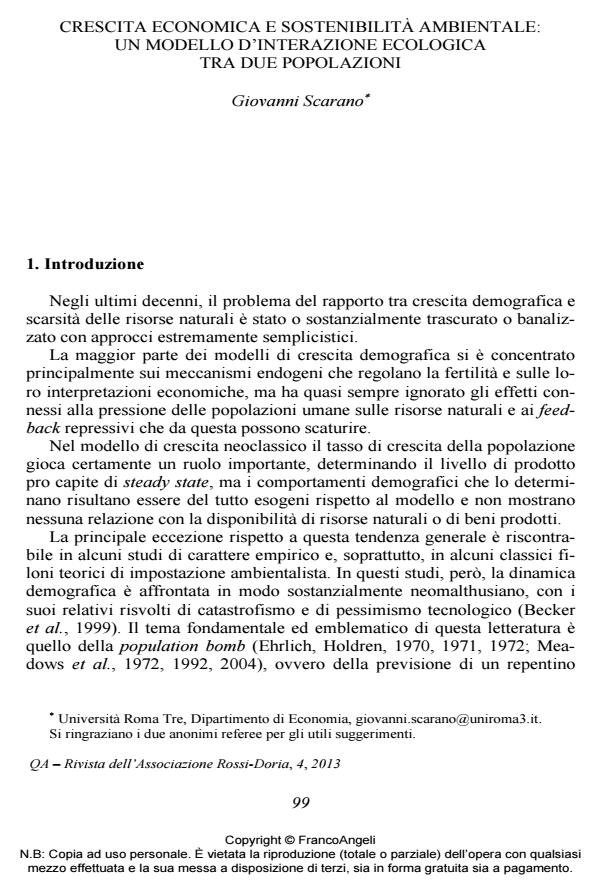Economic Growth and Environmental Sustainability: A Model of Ecological Interaction between Two Populations
Journal title QA Rivista dell’Associazione Rossi-Doria
Author/s Giovanni Scarano
Publishing Year 2014 Issue 2013/4
Language Italian Pages 17 P. 99-115 File size 354 KB
DOI 10.3280/QU2013-004004
DOI is like a bar code for intellectual property: to have more infomation
click here
Below, you can see the article first page
If you want to buy this article in PDF format, you can do it, following the instructions to buy download credits

FrancoAngeli is member of Publishers International Linking Association, Inc (PILA), a not-for-profit association which run the CrossRef service enabling links to and from online scholarly content.
The paper proposes an analysis of the relations between economic growth, population growth and natural ecosystem carrying capacity, applying an ecological economics approach. Starting from construction of a standard economic growth model, we introduce the effect of a natural renewable resource. The aim of the paper is to analyse the sustainable growth conditions emerging from the linear interaction model of the two populations. Connection between the biological and economic aspects of the model is achieved by integrating the concept of carrying capacity for the human population with that of subsistence, a concept of classical economics perfectly consistent with Malthusian demographic analysis. EconLit Classification: O410, O440, J110, Q200
Keywords: Economic Growth, Population Growth, Carrying Capacity, Subsistence, Renewable Resources
- Meadows D.H., Meadows D.L., Randers J. (2004), The Limits to Growth: The 30-Year Update, Chelsea Green Publishing Co., White River Junction (VT).
- Rebelo S. (1991), «Long-Run Policy Analysis and Long-Run Growth», Journal of Political Economy, 99, 3, pp. 500-521.
- Romer P.M. (1986), «Increasing Returns and Long-Run Growth», Journal of Political Economy, 94, 5, pp. 1002-1037.
- Romer P.M., (1990), «Endogenous Technological Change», Journal of Political Economy, 98, 5, part II, pp. S71-S102. Romer D. (2001), Advanced Macroeconomics, McGraw-Hill Inc., New York.
- Scarano G. (2008), «Capital Accumulation, Technological Progress and Environment », International Journal of Global Environmental Issues, 8, 4, pp. 355-365, DOI: 10.1504/IJGENVI.2008.019369
- Scarano G. (2011), «Population, Earth Carrying Capacity and Economic Growth», Rivista di Politica Economica, IV-VI, aprile/giugno.
- Scarano G. (2012), «Population, Earth Carrying Capacity and Economic Growth», in Chiarini B., Malanima P. (eds.), From Malthus’ Stagnation to Sustained Growth, Palgrave MacMillan, London, pp. 142-159.
- Solow R.M. (1956), «A Contribution to the Theory of Economic Growth», Quarterly Journal of Economics, 70, 1, pp. 65-94.
- Solow R.M. (1974), «The Economics of Resources or the Resources of Economics », American Economic Review, 64, 2, pp. 1-14.
- Solow R.M. (1974b), «Intergenerational Equity and Exhaustible Resources», Review of Economic Studies, 41, pp. 29-45.
- Smil V. (1994), «How Many People Can the Earth Feed?», Population and Development Review, 20, 2, pp. 255-292.
- Smulders S. (1999), «Endogenous Growth Theory and the Environment», in van den Bergh J.C.J.M. (ed.), Handbook of Environmental and Resource Economics, Cheltenham, Edward Elgar, Northampton (Mass).
- Verhlust P.F. (1838), «Notice sur la loi que la population suit dans son accroissement », Correspondance mathématique et physique, 10, pp. 113-121.
- Arrow K.J. (1962), «The Economic Implications of Learning by Doing», Review of Economic Studies, 29, pp. 155-173.
- Arrow K., Bolin B., Costanza R., Dasgupta P., Folke C., Holling C.S., Jansson B.O., Levin S., Maler K.G., Perrings C., Third D.P., (1995), «Economic Growth, Carrying Capacity and the Environment», Science, 268, pp. 520-521.
- Barro R.J., Sala-i-Martin X. (1995), Economic Growth, McGraw-Hill, Inc., New York.
- Becker G.S., Glaeser E.L., Murphy K.M. (1999), «Population and Economic Growth», American Economic Review, 89, 2, pp.145-149.
- Bertuglia C.S., Vaio F. (2003), Non linearità, caos, complessità. Le dinamiche dei sistemi naturali e sociali, Bollati Boringhieri, Torino. Clark W.C. (1990), Mathematical Bioeconomics. The Optimal management of Renewable Resources, John Wiley & Sons Inc., New York.
- Cohen J.E. (1995), How Many People Can the Earth Support?, Norton & Co., New York, London.
- Costanza R. (1989), «What is Ecological Economics?», Ecological Economics, 1, pp. 1-7.
- Ehrlich P., Holdren J. (1970), «The People Problem», Saturday Review, 4, pp. 42-43.
- Ehrlich P., Holdren J. (1971), «Impact of Population Growth», Science, 171, pp. 1212-1217.
- Ehrlich P., Holdren J. (1972), «Impact of Population Growth», in Riker R.G. (ed.), Population, Resources and the Environment, Government Printing Office, Washington DC, Usa, pp. 365-377.
- Foley D.K., Michl T.R. (1999), Growth and Distribution, Cambridge (Mass.), Harvard University Press, London.
- Kaldor N. (1957), «A Model of Economic Growth», Economic Journal, 68, pp. 591-624.
- Kelley A.C. (1985), «Population and Development: Controversy and Reconciliation », Journal of Economic Education, 16, 3, pp. 177-188.
- King R.G., Rebelo S.T. (1990), «Public Policy and Economic Growth: Developing Neoclassical Implications», Journal of Political Economy, 98, 5, part II, pp. S126-S150.
- King R.G., Rebelo S.T. (1993), «Transitional Dynamics and Economic growth in the Neoclassical Model», American Economic Review, 83, 4, pp. 908-931.
- Kremer M. (1993), «Population Growth and Technological Change: One Million B.C. to 1990», Journal of Economic Education, 16, 3, pp. 177-188.
- Lomborg B. (2001), The Skeptical Environmentalist, Cambridge University Press, Cambridge.
- Lotka A.J. (1998), Analytical Theory of Biological Populations, Plenum Press, New York, London.
- Malthus T.R. (1970), An Essay on the Principle of Population, Pelican Books, Baltimore (Md.).
- McNamara R.S. (1973), One Hundred Countries, Two Billion People: The Dimensions of Development, Pall Mall Press, London.
- Meadows D.H., Meadows D.L., Randers J., Behrens W. (1972), Limits to Growth, Universe Books, New York.
- Meadows D.H., Meadows D.L., Randers J. (1992), Beyond the Limit. Global Collapse or a Sustainable Future, Earthscan, London.
Giovanni Scarano, Crescita economica e sostenibilità ambientale: un modello d’interazione ecologica tra due popolazioni in "QA Rivista dell’Associazione Rossi-Doria" 4/2013, pp 99-115, DOI: 10.3280/QU2013-004004